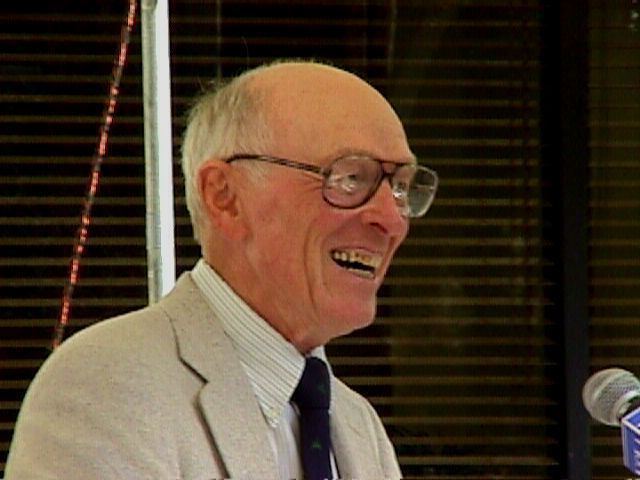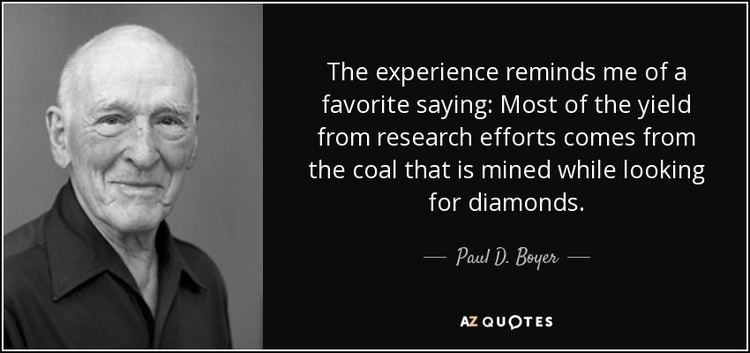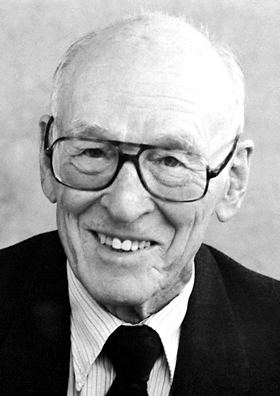Nationality United States Known for Adenosine triphosphate Fields Chemistry Children Gail Boyer Hayes | Name Paul Boyer Grandchildren Lisa A. Hayes Role Chemist | |
Awards Nobel Prize in Chemistry, William C. Rose Award, Guggenheim Fellowship for Natural Sciences, US & Canada Similar People John E Walker, Jens Christian Skou, Denis Hayes | ||
Paul D Boyer
Paul Delos Boyer (born July 31, 1918) is an American biochemist, analytical chemist, and a professor of chemistry at University of California Los Angeles (UCLA) . He shared the 1997 Nobel Prize in Chemistry for research on the "enzymatic mechanism underlying the biosynthesis of adenosine triphosphate (ATP)" (ATP synthase) with John E. Walker, making Boyer the only Utah-born Nobel laureate; the remainder of the Prize in that year was awarded to Danish chemist Jens Christian Skou for his discovery of the Na+/K+-ATPase. He is the oldest living Nobel laureate at age 99.
Contents

Paul D Boyer
Birth and education

Boyer was born in Provo, Utah. He grew up in a nonpracticing Mormon family. He attended Provo High School, where he was active in student government and the debating team. He received a B.S. in chemistry from Brigham Young University in 1939 and obtained a Wisconsin Alumni Research Foundation Scholarship for graduate studies. Five days before leaving for Wisconsin, Paul married Lyda Whicker. They remain married and have three children: Gail B. Hayes, Alexandra Boyer and Dr. Douglas Boyer; and eight grandchildren: Imran Clark, Mashuri Clark, Rashid Clark, Djahari Clark, Faisal Clark, Lisa A. Hayes, Leah Boyer and Josh Boyer.

Though the Boyers connected with the Mormon community in Wisconsin, they considered themselves "on the wayward fringe" and doubted the doctrinal claims of The Church of Jesus Christ of Latter-day Saints (LDS Church). After experimenting with Unitarianism, Boyer eventually became an atheist. In 2003 he was one of 22 Nobel Laureates who signed the Humanist Manifesto.
Academic career
After Boyer received his Ph.D. degree in biochemistry from the University of Wisconsin–Madison in 1943, he spent years at Stanford University on a war-related research project dedicated to stabilization of serum albumin for transfusions. He began his independent research career at the University of Minnesota and introduced kinetic, isotopic, and chemical methods for investigating enzyme mechanisms. In 1955, he received a Guggenheim Fellowship and worked with Professor Hugo Theorell on the mechanism of alcohol dehydrogenase. In 1956, he accepted a Hill Foundation Professorship and moved to the medical campus of the University of Minnesota. In 1959-1960, he served as Chairman of the Biochemistry Section of the American Chemical Society (ACS) and in 1969-1970 as President of the American Society of Biological Chemists.
Since 1963, he has been a Professor in the Department of Chemistry and Biochemistry at University of California, Los Angeles. In 1965, he became the Founding Director of the Molecular Biology Institute and spearheaded the construction of the building and the organization of an interdepartmental Ph.D. program. This institutional service did not diminish the creativity and originality of his research program, which led to three postulates for the binding mechanism for ATP synthesis—that energy input was not used primarily to form ATP but to promote the binding of phosphate and mostly the release of tightly bound ATP; that three identical catalytic sites went through compulsory, sequential binding changes; and that the binding changes of the catalytic subunits, circularly arranged on the periphery of the enzyme, were driven by the rotation of a smaller internal subunit.
Paul Boyer was Editor or Associate Editor of the Annual Review of Biochemistry from 1963-1989. He was Editor of the classic series, "The Enzymes". In 1981, he was Faculty Research Lecturer at UCLA. In that same year, he was awarded the prestigious Tolman Medal by the Southern California Section of the American Chemical Society.
